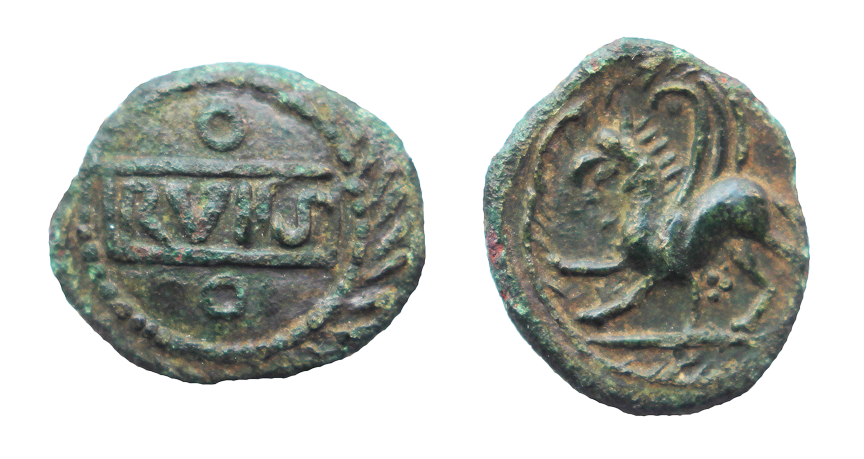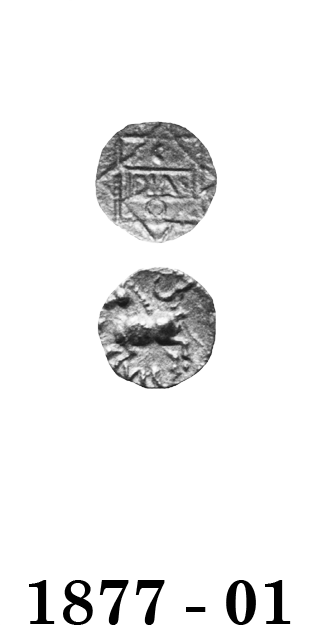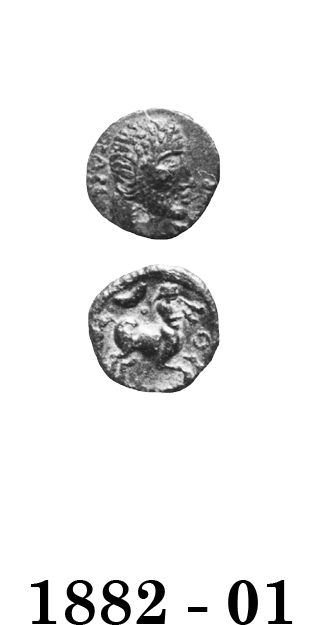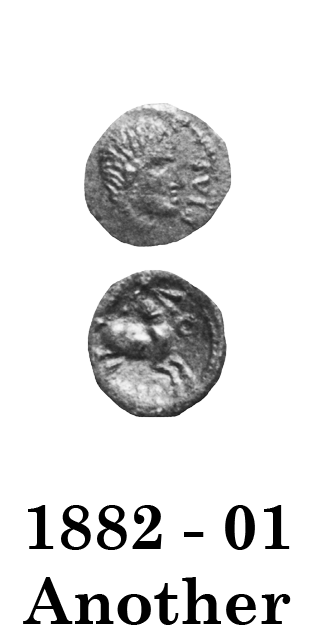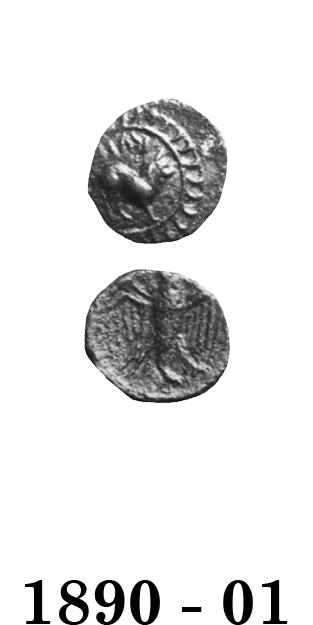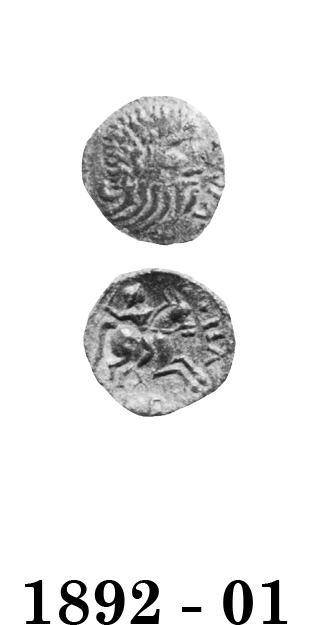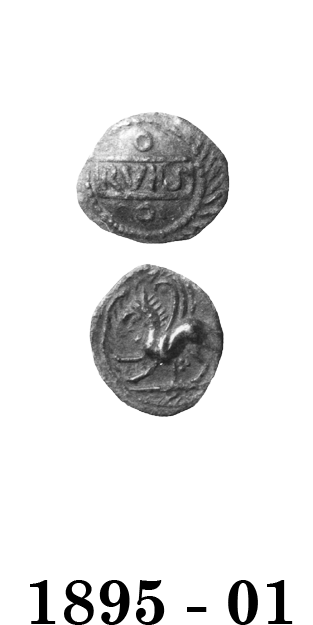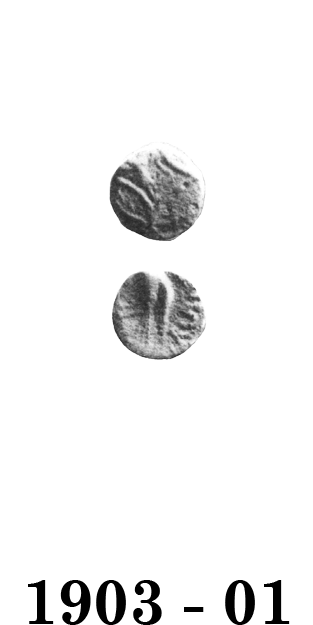
Celtic Coinage of Britain
third edition
Click on coin to see hidden information
The "Interregnum"
In 1944, Derek Allen published an analysis of the inscribed British coinages in Archaeologia. He had difficulty explaining a 30 year gap between the end of Tasciovanus' reign, and the start of Cunobeline's. He also faced problems with coins carrying enigmatic legends linking Tascio with Sego, Andoco and Dias. Another series inscribed RVES or RVIIS also posed unanswerable questions.
Since Allen's time, the gap has been narrowed to 20 years, but still appears inexplicable. The rarity of the Sego, Andoco, Dias and RVIIS types has not helped clarify matters. These coins have been known since 1864 (or earlier), and are certainly genuine. Most numismatists have accepted that the four types are somehow associated with Tasciovanus, and appear late in his reign, or just after it.
Celtic Coinage of Britain offered the simplification that the 20 year gap was an "Interregnum" between Tasciovanus and Cunobeline, and the gap was filled with the coins inscribed Sego, Andoco, Dias and RVIIS. Predictably, this suggestion failed to meet anyone's approval. Yet, no better explanation has surfaced since 1989, despite much analysis and debate.
From 2000 to 2007, Reiner Kretz published a series of papers on the four enigmatic types. These were based on very detailed studies of typology and philology, including careful analyses of findspot distributions, weights and metallurgy. The work failed to clarify the overall picture, but did add useful details to the story. He suggested that the coinage of Andoco may overlap or be entirely included within Tasciovanus' Third Coinage. He suggested an imaginative interaction between two rulers. He added further speculation about Andoco's reactions to and concerns about Tasciovanus. This work, predictably, has not met everyone's approval, either.
There has always been a question whether Sego, Andoco, Dias and RVIIS are names of rulers, or mean something entirely different. Kretz' work demonstrated the legends carry plausible names or epithets, and he suggested numerous possibilities.
With little else to go on, this catalogue continues the idea of an "Interregnum". The construction is far from complete, but no better replacement has surfaced in recent years. The four types are listed here, with no suggestions regarding their chronological relationship. The dates for all four types are expanded to include the end of Tasciovanus' reign, anticipating that Kretz' dating for Andoco could apply to any of the types. Also, following Kretz work on the legends, the mint for RVIIS coin has been dropped (it had been Verulamium since Evans' 1864 book).
Though additional research may clarify things in the future, one begins to fear we may never explain the period from 10 BC to 10 AD north of the Thames.
Coins Inscribed DIAS
A few silver and bronze coins carry the legend DIAS. All are known from a small number of surviving examples. Dias has been usually been considered a minor contestant for the Trinovantian/Catuvellaunian leadership, but this is not completely certain. Though "DIAS" may not refer to a person, Kretz has suggested possible names corresponding to the legend.
Coins Inscribed RVIIS or RVES
To date, only bronze coins carry the legend RVIIS or RVES, and like DIAS may signify a minor contestant for the Trinovantian/Catuvellaunian leadership. Conceivably, "RVES" may not refer to a person. Kretz, however, has suggested plausible names corresponding to the legend.
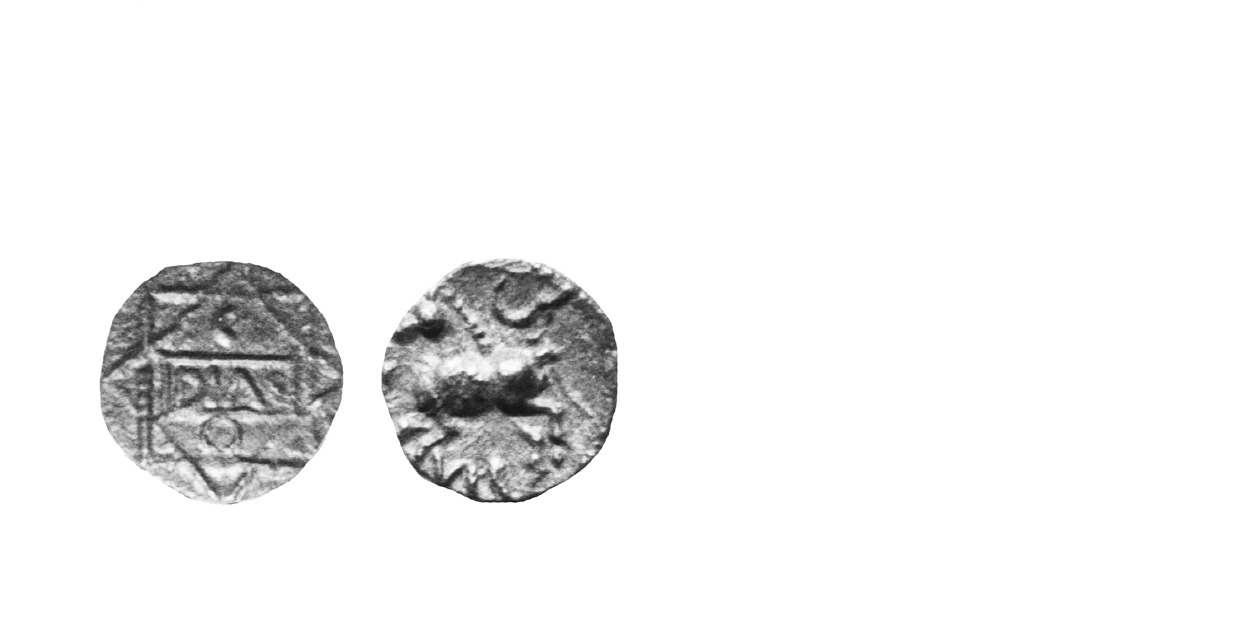
1877 - 01 DIAS
15 B.C.-10 A.D. Very Rare
Silver Unit 1.3 gms. 13 mm
Earliest Record: Camden, 1610 (Philemon Holland edition)
OBV: Inscription in tablet
Identifying points:
1) two interlaced squares
2) tablet with DIAS in centre
3) letter 'C' above tablet
4) letter 'O' below tablet
REV: Celticized horse left
Identifying points:
1) curve above horse
2) VIR below horse
CLASSIFICATION: Trinovantian R
NOTES:
- Celtic Coin Index records now indicate commoner than previously thought
- Some in museums
- Verulamium mint
1879 - 01 DIAS
15 B.C.-10 A.D. Extremely Rare
Silver Unit 1.3 gms. 13 mm
Earliest Record: Celtic Coin Index, 1993 (Baldock Excavations, 1981)
OBV: Elaborate geometric design
Identifying points:
1) "wreath" of two lines of pellets, intertwined, for border
2) ring of pellets inside "wreath"
3) large saltire, over square of pellets in centre
4) "X" over saltire
REV: Celticized boar right
Identifying points:
1) DIAS below boar
CLASSIFICATION: Trinovantian R
NOTES:
- Some in museums
- One coin found during archaeological excavations in Baldock, so type is probably genuine
- Not Illustrated
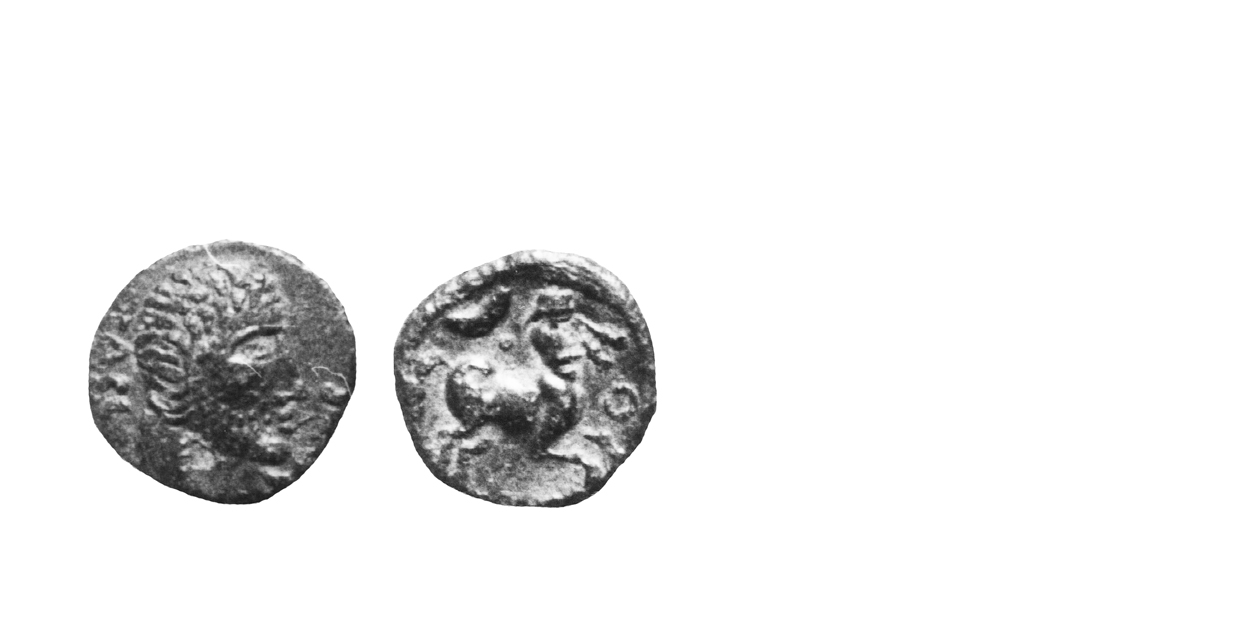
1882 - 01 DIAS
15 B.C.-10 A.D. Scarce
Bronze Unit 1.3-1.6 gms. 13 mm
Earliest Record: Evans, 1864
OBV: Head of Hercules right
Identifying points:
1) beard and short hair
2) TASC DIAS around head
REV: Centaur right
Identifying points:
1) Centaur plays double pipes
2) ring in front of Centaur
3) curve above Centaur
4) VER in field
CLASSIFICATION: Trinovantian R
NOTES:
- Celtic Coin Index records now indicate commoner than previously thought
- Some in museums.
- Head of Hercules copied from Roman denarius of Cn. Domitius M.f. M.n. Calvinus, or is adapted from an intaglio such as the Vetera I intaglio
- Verulamium mint
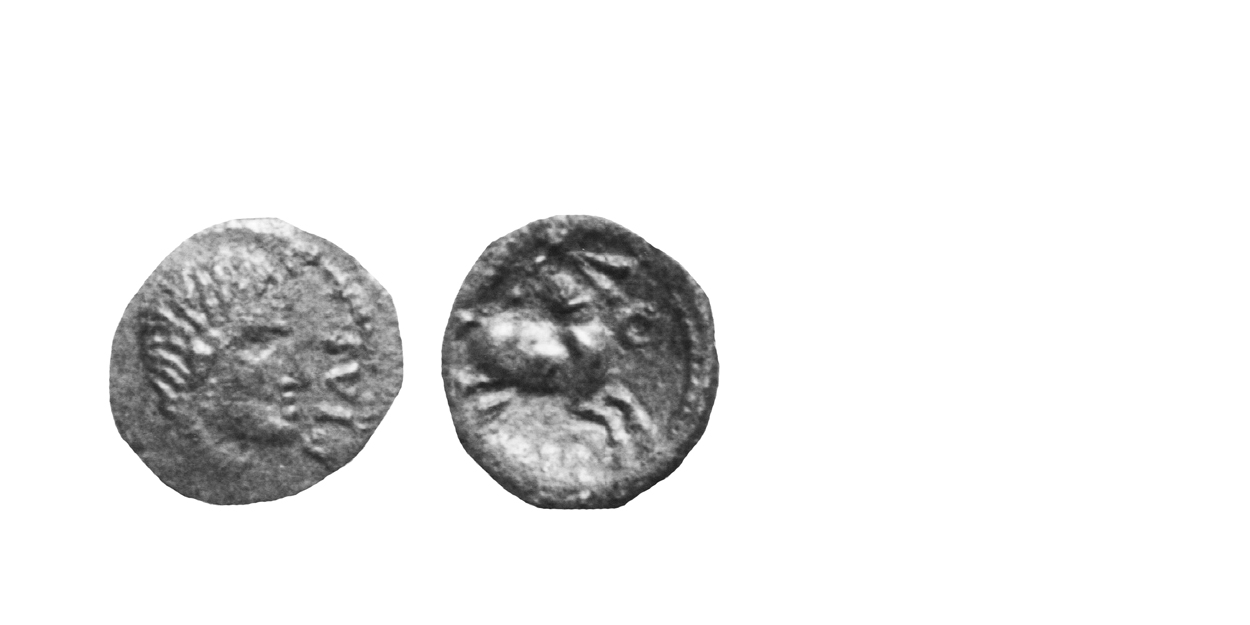
1882 - 01 DIAS
15 B.C.-10 A.D. Scarce
Bronze Unit 1.3-1.6 gms. 13 mm
Earliest Record: Evans, 1864
OBV: Head of Hercules right
Identifying points:
1) beard and short hair
2) TASC DIAS around head
REV: Centaur right
Identifying points:
1) Centaur plays double pipes
2) ring in front of Centaur
3) curve above Centaur
4) VER in field
CLASSIFICATION: Trinovantian R
NOTES:
- Celtic Coin Index records now indicate commoner than previously thought
- Some in museums.
- Head of Hercules copied from Roman denarius of Cn. Domitius M.f. M.n. Calvinus, or is adapted from an intaglio such as the Vetera I intaglio
- Verulamium mint
1882 - 03 DIAS
15 B.C.-10 A.D. Extremely Rare
Bronze Unit 1.6 gms.
Earliest Record: Van Arsdell, 1989
OBV: Head of Hercules right
Identifying points:
1) beard and short hair
2) TASC DIAS around head
REV: Horse
Identifying points:
1) ring in front of horse
2) curve above horse
3) VER in field
CLASSIFICATION: Trinovantian R
NOTES:
- Not illustrated
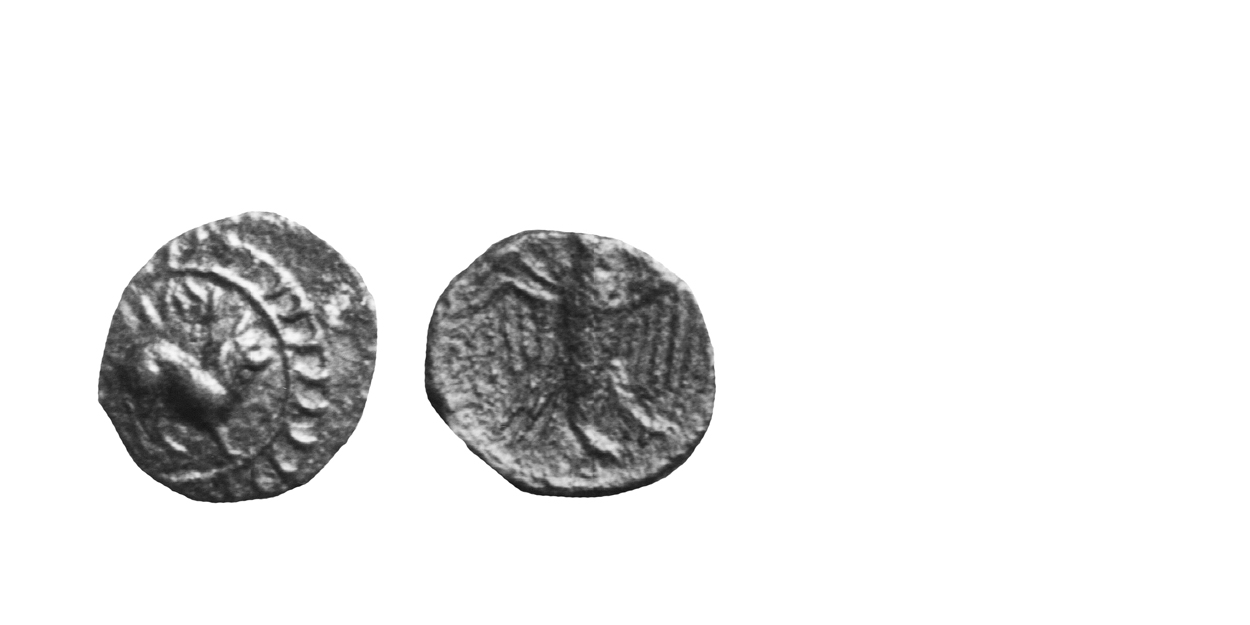
1890 - 01 RVIIS or RVES
15 B.C.-10 A.D. Scarce
Bronze Unit 2.4 gms. 15 mm
Earliest Record: Evans, 1890
OBV: Lion right
Identifying points:
1) lion in bezel
2) RVII or RVEI around lion
REV: Eagle
Identifying points:
1) eagle stands with spread wings
2) RVII above eagle
CLASSIFICATION: Trinovantian S
NOTES:
- Celtic Coin Index records now indicate commoner than previously thouyght
- Obverse adapted from a Roman denarius of Mark Anthony
- Reverse adapted from a Roman denarius of Augustus
- Kretz has convincingly argued all varieties of this type carry a legend RVII on the reverse
1890 - 03 Deleted
Reiner Kretz has convincingly demonstrated that all varieties contain an RVII legend on the reverse. Earlier examples had the legend off the flan.
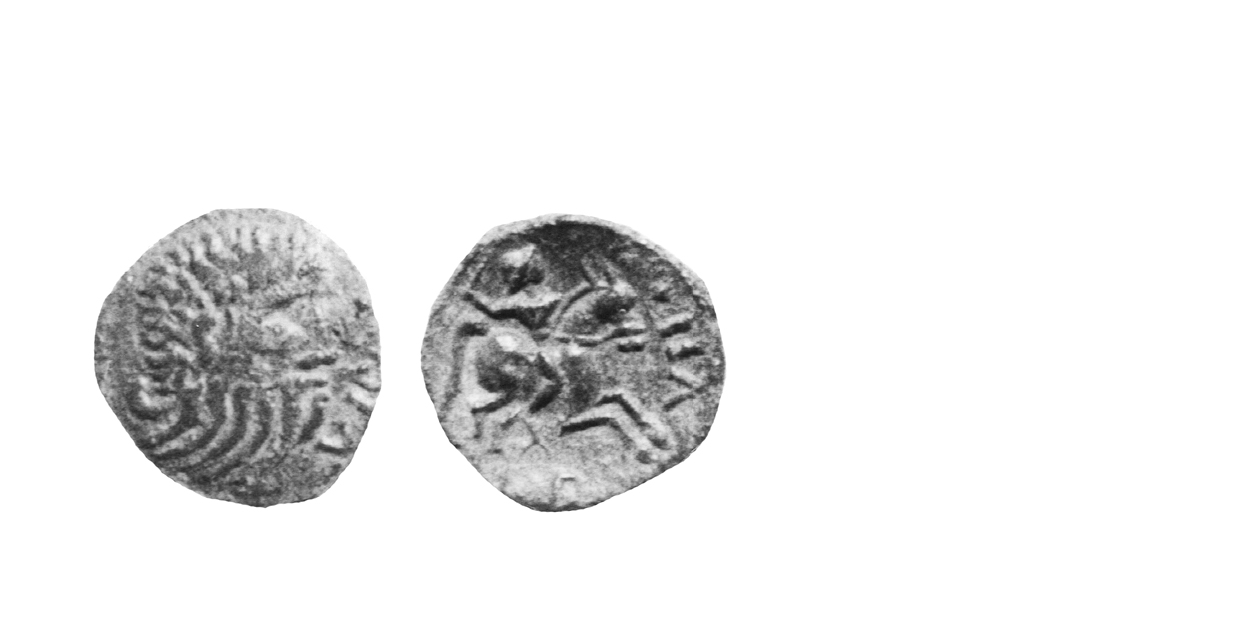
1892 - 01 RVIIS or RVES
15 B.C. 10 A.D. Scarce
Bronze Unit 1.9 gms. 15 mm
Earliest Record: Evans, 1864
OBV: Celticized head right
Identifying points:
1) similar to 1707 - 01 (see 1707 - 01)
2) RVIIS in front of face
REV: Celtic warrior on horse right
Identifying points:
1) RVII around horse
2) warrior brandishes spear or carnyx
CLASSIFICATION: Trinovantian S
NOTES:
- Celtic Coin Index records now indicate commoner than previously thought
- Mint no longer certain, Evans had suggested Verulamium in 1864
- Kretz has provided a better reading of the reverse legend, RVII not VIR
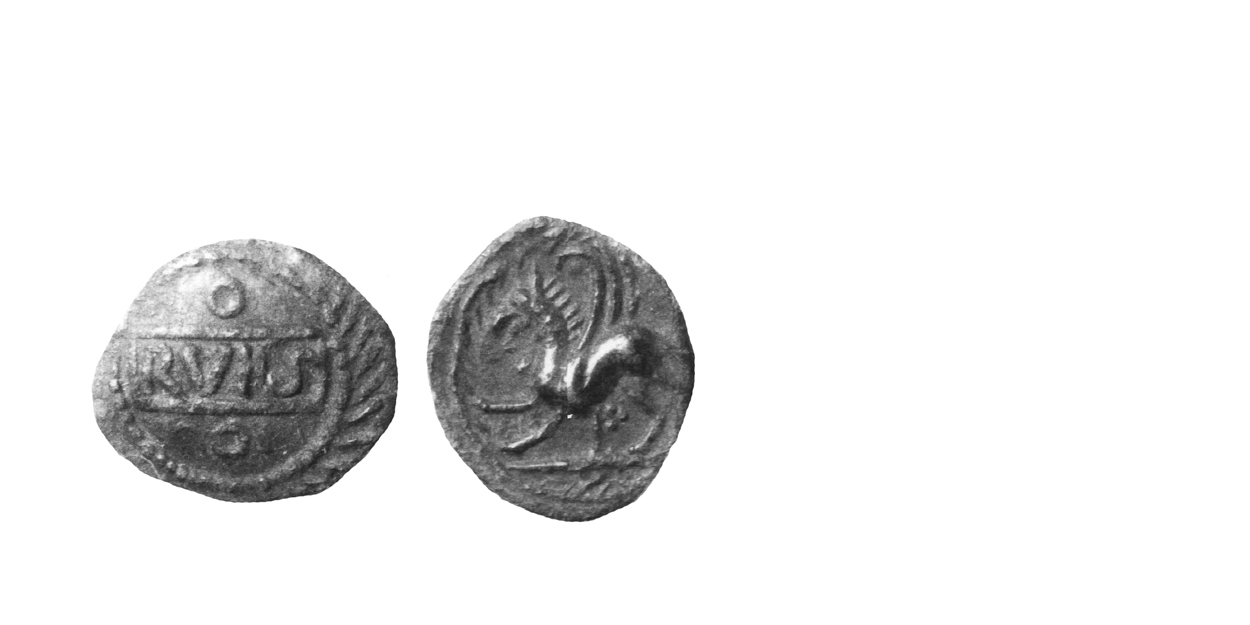
1895 - 01 RVIIS or RVES
15 B.C.-10 A.D. Very Rare
Bronze Unit 1.9 gms. 14 mm
Earliest Record: Evans, 1864
OBV: Inscription in tablet
Identifying points:
1) RVIIS in tablet
2) ring above and below
3) bezel around edge
REV: Griffin left
Identifying points:
1) exergue line below griffin
2) three pellets below griffin
CLASSIFICATION: Trinovantian S
NOTES:
- Some in museums
- Mack was uncertain about the animal, better centred examples now show it to be a griffin
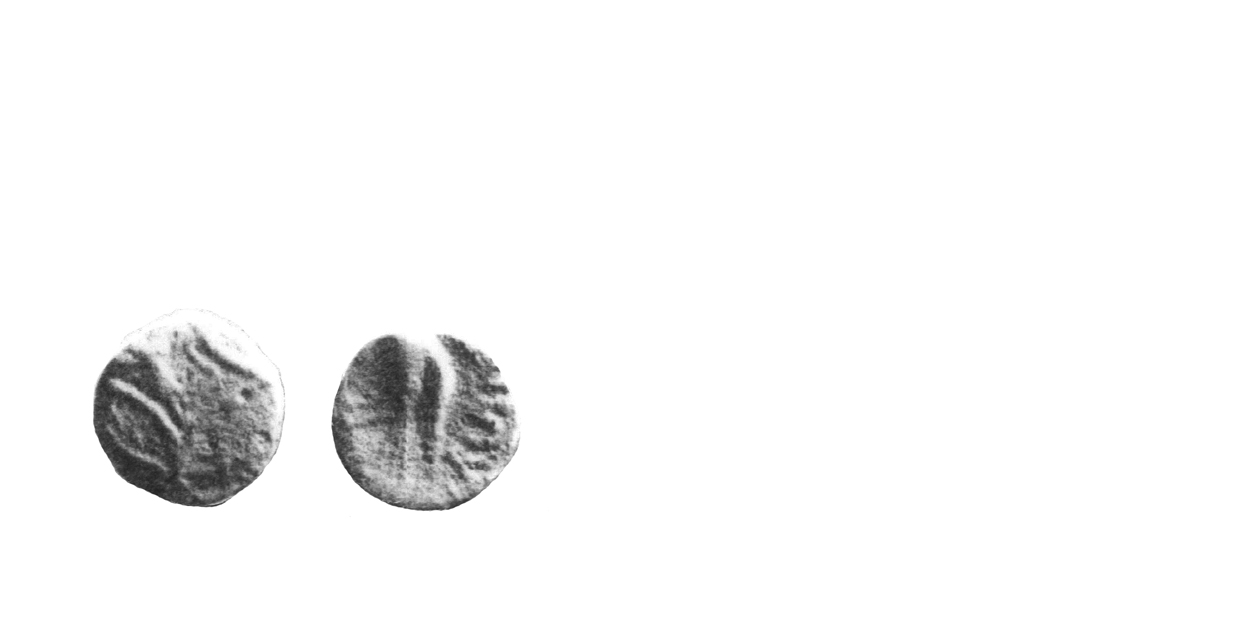
1903 - 01 RVIIS or RVES
15 B.C.-10 A.D. Very Rare
Bronze Fraction 0.6-0.9 gms. 12 mm
Earliest Record: Evans, 1864
OBV: Geometric pattern
Identifying points:
1) two curved-side squares, one inside the other
2) ring in centre
REV: Eagle right
Identifying points:
1) RVII to right of eagle
2) eagle has wings partly folded
CLASSIFICATION: S
NOTES:
- Celtic Coin Index records now indicate commoner than previously thought
- Some in museums
- The bronze fractional unit is not a normal British denomination, however the coin is inscribed and is thus certain to be a RVES issue
- Appears to be struck on an undersized flan (because less than half the image is on the coin) – it probably was intended to be a Bronze Unit
Coinage of the Trinovantes/Catuvellauni
Traditionally, the Trinovantes and Catuvellauni were considered distinct tribes, each with its own coinage. An elaborate history, written from the coin inscriptions, described a long intertribal warfare. The Trinovantes received blow after devastating blow from the warlike Catuvellauni and lost Camulodunum, their tribal capital, several times in the process. The evidence was founded partially on Caesar's writings – the ruler of the Trinovantes had been killed by Cassivellaunus. Cassivellaunus was assumed to be a ruler of the Catuvellauni, though Caesar never stated so. The rest of the support came from an analysis of the findspots of the Dynastic coins.
Today, this history is considered a myth – the coin evidence no longer supports continual internecine warfare north of the Thames. Cassivellaunus' tribal origin is not mentioned by any contemporary writer and there is no indication he was the ruler of the Catuvellauni. The similarity of the tribal and personal names is coincidence, not a link between the two. Furthermore, recent analyses of the findspot distributions indicate the coins circulated farther afield than previously thought. The territory north of the Thames can no longer be separated into two distinct coin-using zones.
Instead, the coinage is seen today as that of a single economic group – coin types appear in succession and circulate not only throughout the area immediately north of the Thames, but into Icenian and Cantian territory as well. Metrology and typology show the inscriptions on the dynastic issues are those of successive rulers, not contemporary adversaries.
In general, the picture today is of a powerful, united tribe occupying the area north of the Thames. The unification must have occurred shortly before the Gallic War, or during it. This unified tribe had economic influence beyond its borders which increased throughout the period of the coinage. The tribal group ultimately controlled the economy of the Cantii, and to a lesser extent the economies of the Iceni and Atrebates/Regni/Belgae.
But what was this group group?
That two tribes existed is not in doubt. Caesar mentions the Trinovantes in his Gallic War commentaries, stating they were probably the most powerful tribe in southern Britain. The Catuvellauni are mentioned on an inscribed Roman stone from Hadrian's wall. There were two minting centres in the territory, at the tribal oppida of Verulamium and Camulodunum, suggesting two political centres existed. However, the coinage is a unified one since the two tribal groups must have merged into a single economic unit before they started producing coins. As a result, the tribes cannot be distinguished numismatically, and they are referred to as the Trinovantes/Catuvellauni. For all practical purposes, by the introduction of the Whaddon Chase Type about 55 B.C., they had come to act as one economically, and perhaps had been doing so as early as 125 B.C. The inscribed coinage argues for political unity by 40 B.C. as well. The dynastic coins show an orderly succession of rulers, except for a brief period around the turn of the millenium. This appears to have been an Interregnum, during which the succession was disputed.
The Trinovantes/Catuvellauni occupied the entire territory immediately north of the Thames. They were bounded on the north-east by the Iceni, on the south by the Cantii and Atrebates/Regni/Belgae, on the north the by the Corieltauvi, and on the west, probably, by the Dobunni. Thus, they were in physical contact with all the tribes of the south-east, and in a position to exert influence.
By 125 B.C.. they were importing coins from the Ambiani on the Continent, and shared the cross-Channel trade with the Cantii and Atrebates/Regni. Large Flan, Defaced Die and Abstract Type gold coins are found throughout their territory in quantity.
When the Cantii began casting bronze coins about 100 B.C., the Trinovantes/Catuvellauni followed this lead and produced their own cast coinage for a brief period. In the early 1980s a small hoard of unusual cast bronze coins was dispersed in Europe, about 100 to 300 pieces with an alleged 'Folkestone findspot'. At first this was dismissed as incorrect, and the coins branded Gaulish. However, during the late summer of 1987 a hoard of about 2,000 cast bronzes, including the unusual type, were found in a pit in the vicinity of West Thurrock, Essex. The coins occurred in at least sixteen varieties, with a reasonable typological progression. One coin had a large protrusion of flash which would have broken off had the coin been moved any great distance. In general, the hoard appeared to be made up of coins collected by a mint, perhaps for remelting. No other evidence of minting activity was noted at the site, but it appears the mint cannot have been far away.
THURROCK TYPE cast bronzes are also found as single finds in Essex. A few have been found in the Thames River and one coin was found in Dorset. Many single finds and one small hoard have been found in Kent, prompting some to the conclusion they are a Kentish issue. The coins cannot have been used for a very long time. Three interpretations are likely: 1) they have a Gaulish origin and were briefly imported, 2) they have a British origin and represent the first coinage of the Trinovantes/Catuvellauni, or 3) they are a Kentish issue. Although similar coins are reported from the Continent (Castelin, 1978, numbers 477 to 485), they are not sufficiently alike to have a common Gaulish origin. Thus, of the three interpretations, the Gaulish origin appears the least likely. The Thurrock Hoard, representing a complete corpus of the series, would have been very difficult to assemble outside the mint – it very well may be a hoard of mint scrap. Thus, the suggestion here is that the Thurrock Hoard was produced in the vicinity of the findspot – the coins representing a Trinovantian/Catuvellaunian issue.
Thurrock Types appear to have been influenced by the Prototype Period cast bronzes of the Cantii, dating them about l00 to 90 B.C. Within twenty years, the tribe was striking its own gold coinage.
The Trinovantes/Catuvellauni were one of the earliest tribes to begin striking gold staters, with the introduction of the CLACTON and NORTHERN WESTERHAM TYPES around 70-60 B.C. A hoard of the CLACTON TYPES was found with Ambiani Abstract Type staters at Clacton beach. This type, like all the early types struck in Britain was, short-lived – submerged by the large influx of Gallic War staters. About the middle of the war, the tribe began to strike the WHADDON CHASE TYPE, and continued to produce coins until the Claudian invasion a hundred years later.
The Trinovantes/Catuvellauni apparently collaborated with the Romans during the War. They probably did this by hampering trade between the Durotriges and the Armorican tribes, by competing for supplies within Britain. They may have delivered supplies directly to the Roman army, as well. The tribe obtained a large amount of gold for this effort and evidently became the recipient of wine-trading rights with the Romans. This favour ultimately gave the tribe an economic superiority over all the other tribes in the southeast after the war.
The tribe operated two mints, one at Verulamium, the other at Camulodunum. Initially, the Verulamium mint produced most of the coins, but it was overshadowed by Camulodunum in the first century A.D. The remains of both mints have been found during archaeological excavations.
It has long been asserted that Caesar gave coin-manufacturing assistance during his visit in 54 B.C., because the coins of the period display Romanizing influences. Training was probably unnecessary, however, because the moneyers would have been expert metal-workers already. The die-cutting on Whaddon Chase staters is excellent, but surprisingly, the dies were cut in soft metal. They broke up quickly and many of the existing pieces show die-damage. Sometimes depressions appear where the die surface heaved up during punching. Normally, the heaved surfaces would have been planed off, but this was not done for some reason. All this suggests that the minting was hurried, not unusual for a time of war.
The Trinovantes/Catuvellauni continued to produce coins after the War, and there appears to be little reduction in the amount produced. A silver coinage started either during the War or just after. Shortly after Commius placed his name on the Atrebatic/Regnan/Belgic coinage, the tribe began its own dynastic series, probably around 40 B.C. By this time the tribe was producing bronze coins for small change, as well as gold and silver. The series of inscribed coins gives the names of the successive tribal leaders for the next eighty years.
